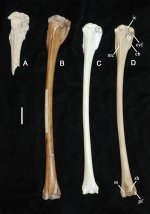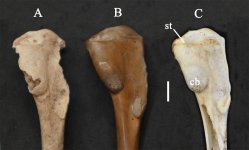Fred Ruhe
Well-known member

JULIAN P. HUME. 2023
A new fossil subspecies of booby (Aves, Sulidae: Papasula) from Mauritius and Rodrigues, Mascarene Islands, with notes on P. abbotti from Assumption Island
Zootaxa 5270 (3): 507–536
doi:10.11646/zootaxa.5270.3.5
Abstract: A new fossil subspecies of booby (Aves, Sulidae: Papasula ) from Mauritius and Rodrigues, Mascarene Islands, with notes on P. abbotti from Assumption Island | Zootaxa
A new subspecies of Papasula booby is described from fossil remains collected in the Mascarene Islands of Mauritius and Rodrigues, southwestern Indian Ocean. The Mascarene Booby Papasula abbotti nelsoni ssp. nov., larger than nominate Abbott’s Booby P. a. abbotti from Christmas Island, northeast Indian Ocean, was approximately the same size as the extinct Hiva Oa Booby P. a. costelloi from the Marquesas in the Eastern Pacific. Mentioned in early accounts of Mauritius in 1668 and in 1725–26 and 1761 on Rodrigues, the Mascarene booby became extinct by the end of the 18th century. Members of another isolated but now extirpated population of Papasula abbotti from Assumption Island in the Seychelles Archipelago, the island from which the type specimen was collected, are identical to extant Christmas Island birds in size and colouration and discussed in detail herein.
Enjoy,
Fred
A new fossil subspecies of booby (Aves, Sulidae: Papasula) from Mauritius and Rodrigues, Mascarene Islands, with notes on P. abbotti from Assumption Island
Zootaxa 5270 (3): 507–536
doi:10.11646/zootaxa.5270.3.5
Abstract: A new fossil subspecies of booby (Aves, Sulidae: Papasula ) from Mauritius and Rodrigues, Mascarene Islands, with notes on P. abbotti from Assumption Island | Zootaxa
A new subspecies of Papasula booby is described from fossil remains collected in the Mascarene Islands of Mauritius and Rodrigues, southwestern Indian Ocean. The Mascarene Booby Papasula abbotti nelsoni ssp. nov., larger than nominate Abbott’s Booby P. a. abbotti from Christmas Island, northeast Indian Ocean, was approximately the same size as the extinct Hiva Oa Booby P. a. costelloi from the Marquesas in the Eastern Pacific. Mentioned in early accounts of Mauritius in 1668 and in 1725–26 and 1761 on Rodrigues, the Mascarene booby became extinct by the end of the 18th century. Members of another isolated but now extirpated population of Papasula abbotti from Assumption Island in the Seychelles Archipelago, the island from which the type specimen was collected, are identical to extant Christmas Island birds in size and colouration and discussed in detail herein.
Enjoy,
Fred






